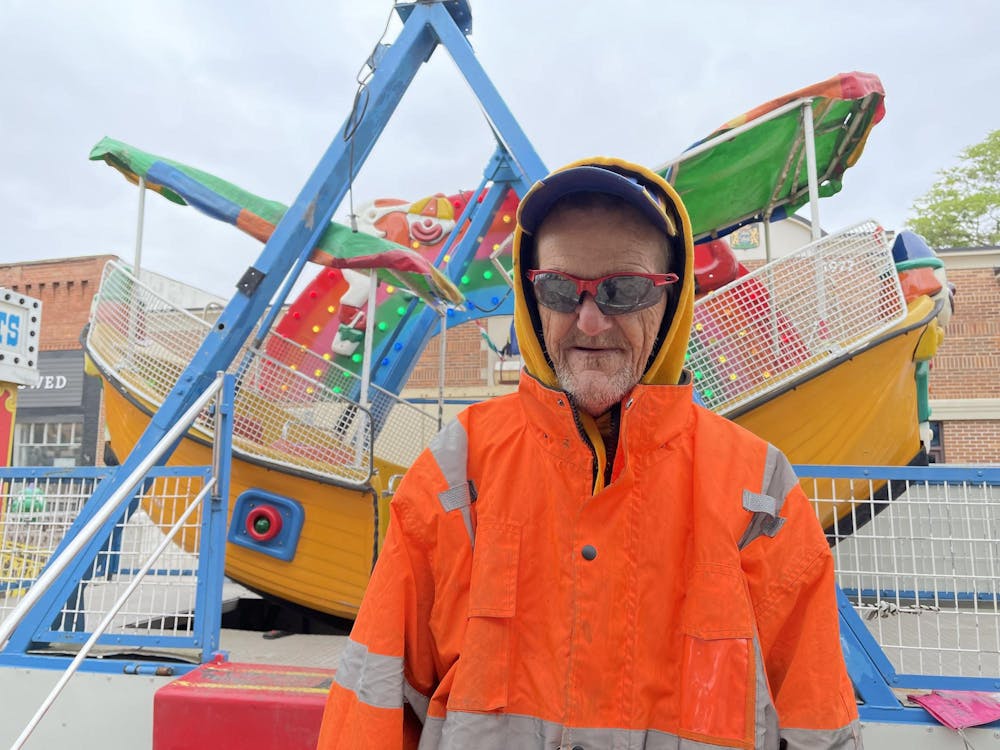This article was written during World Journalism Institute, College Course 2025 – Editor.
ORANGE CITY — Little craters of blackheads decorated Denis Stewart’s 63-year-old face.
He put the pink tickets between his lips and opened the gate to the carnival boat ride. Two little blonde girls climbed up and into the boat. As the ride operator, he secured the guardrail without saying a word.
He descended the stairs and began pressing a blue button, which he continuously punched for a few minutes to send the boat backwards and forwards.
Within minutes, the ride was over.
Stewart stood on the boat once again. As he removed the safety guardrail, the girl with purple glasses stared wide-eyed at him. Not scared, but perhaps curious.
He had a protruding chin and wore a glum expression. Red sunglasses hid his eyes.
The girls stepped down, and the cycle repeated: Parents paid pink tickets to Stewart. He opened the gate; kids walked in. He secured the guardrail and punched the blue button.
The monotonous routine may make a person wonder what a carnival worker’s life is like.
Carnival workers never stay in one location for long. The job consists of putting-up and tearing-down camp just for a new destination. Denis Stewart shed some light into his life as a ride operator: The highs, lows and — well — the expected.
Being a carnival ride operator is a difficult job, he said. The weather can be brutal. Rides do not always cooperate and traveling to other locations on time can be challenging.
“It's better than some things you can do, you know,” Stewart said. “It's a hard life, really.”
The employee turnover rate is high at Midwest Rides, he said. The company hires just about anyone. Every night he locks his door because he feels unsafe staying near his coworkers.
In a way, he said, his coworkers are like family. Except that they argue and aren’t friends.
Stewart does have his moments of fun operating rides. But his real passion is fixing-up antique cars which overlaps with operating carnival rides. Like cars, the rides need to be sandblasted every so often, then primed, painted and rewired, he said.
Stewart’s father and grandfather liked fixing vehicles. He naturally followed in their footsteps.
His favorite car is the red 1972 Chevrolet Nova.
Once, Stewart’s grandma asked him to remodel her vehicle. The car’s body and interior were brown with plain rims. He painted the car, replaced the cylinders and turned it into a “hotrod,” blaring with sound.
He took grandma for a ride and she screamed, “What’ve you done!”
Eventually, she loved the car, he claimed.
From the age of six into his 30s, Stewart found himself in vehicle junkyards.
He earned several scars from digging in piles of car scraps. With arms out in front of him, he displayed his right hand. His thumb missed a chunk of nail.
Stewart said the scars are really a blessing because each is a memory.
“That scar right there,” he said, motioning to a white scar running down his index finger. “I was working on a Volkswagen. I cut it on the fender when I was seven-years-old — that's a memory.”
Years later, he also made memories with his friends, playing music in the junkyard. They turned on the radio and brought out their guitars. They often played rock and sometimes “Amazing Grace.”
“I mean, it's (a) really odd place to do it, but it's such a big spread-out place (that) nobody grips about the noise,” he said.
Those days in the junkyard came to an end because he was “burning daylight.” He needed an income. Now, having been a ride operator for 11 years with Midwest Rides, he’s tired of working.
What does he want to do in the future?
“Retire,” he said. “And do some kind of passion. I’ll probably start rebuilding cars again.”
Within the hour, Stewart was paid pink tickets and returned to pushing the blue button.



